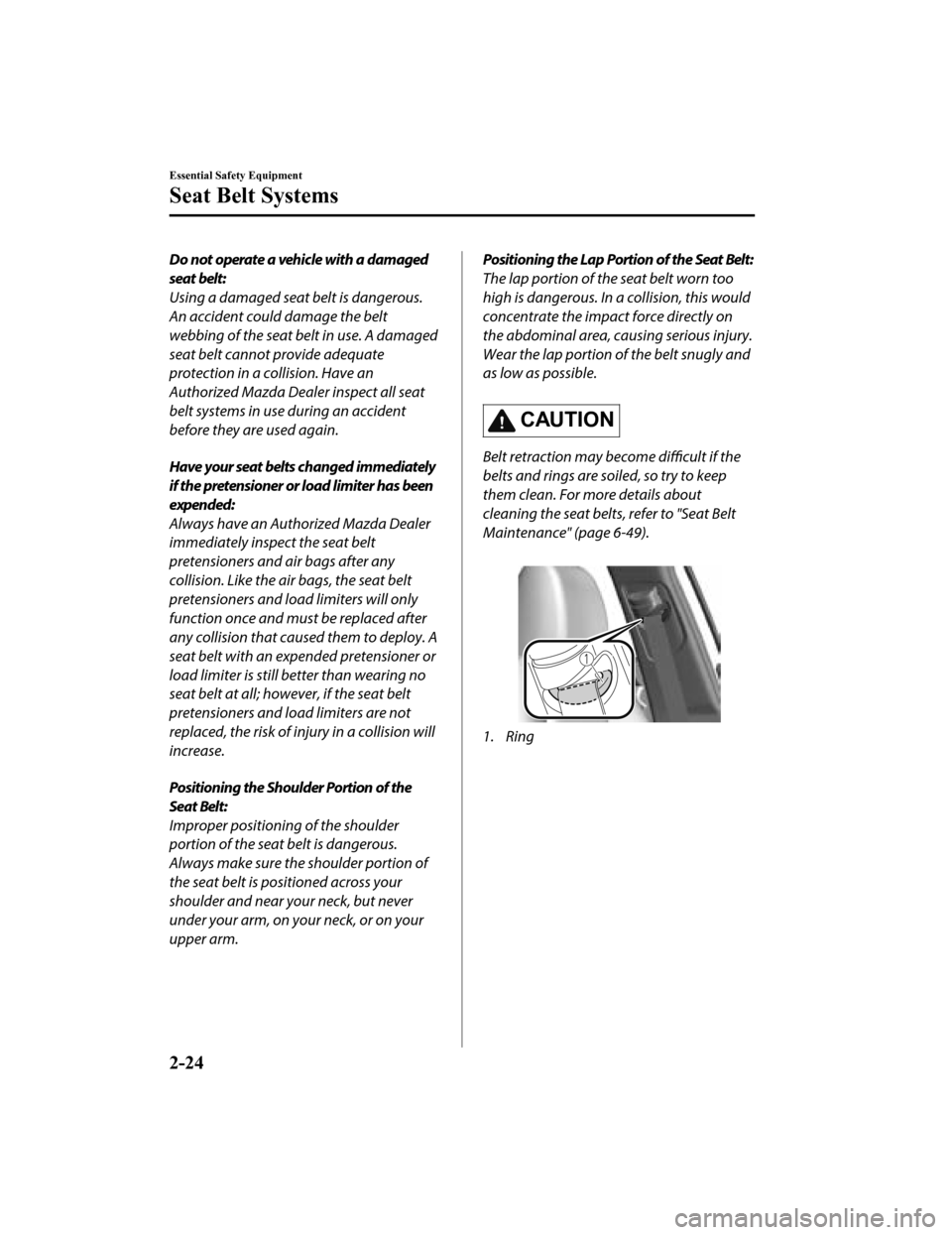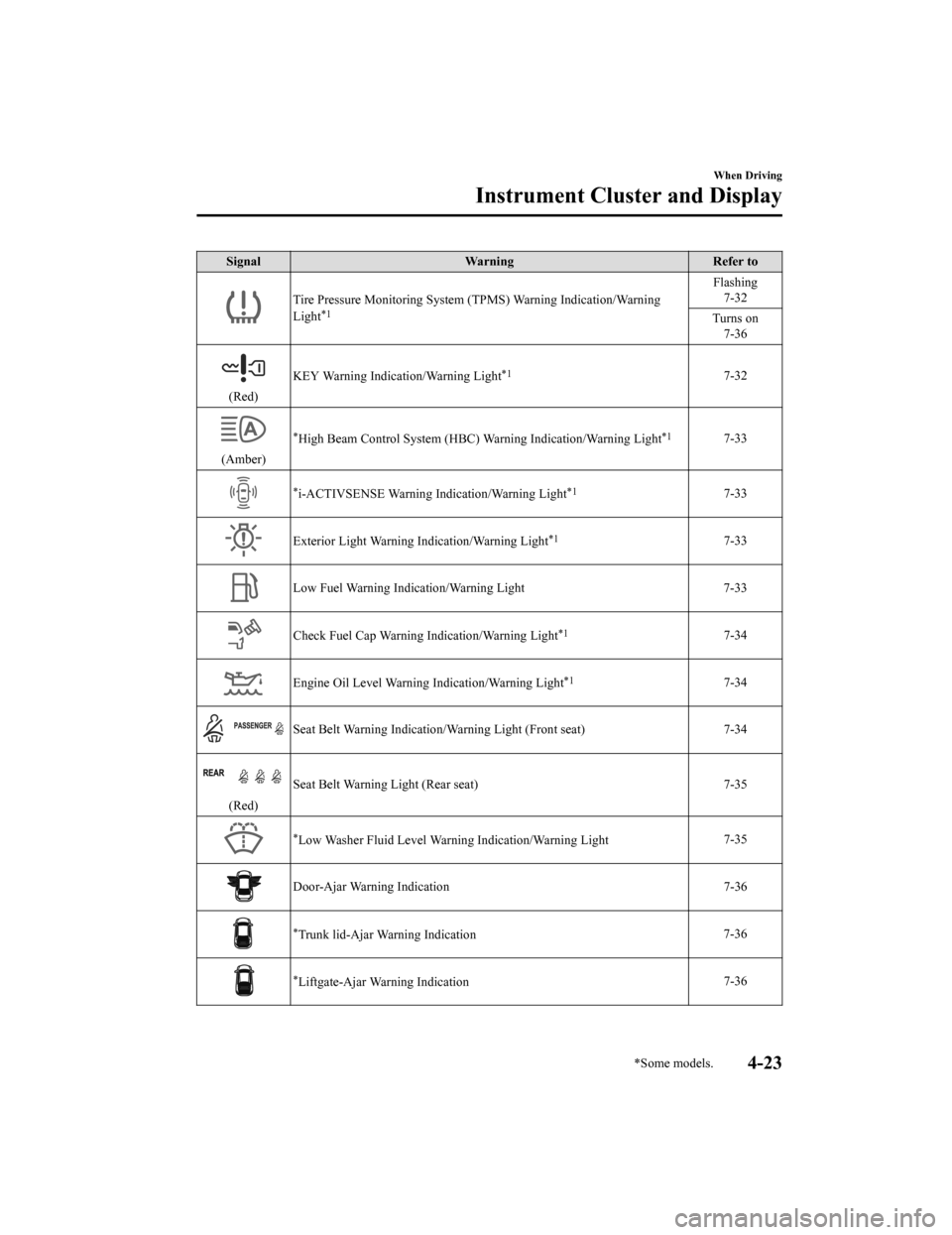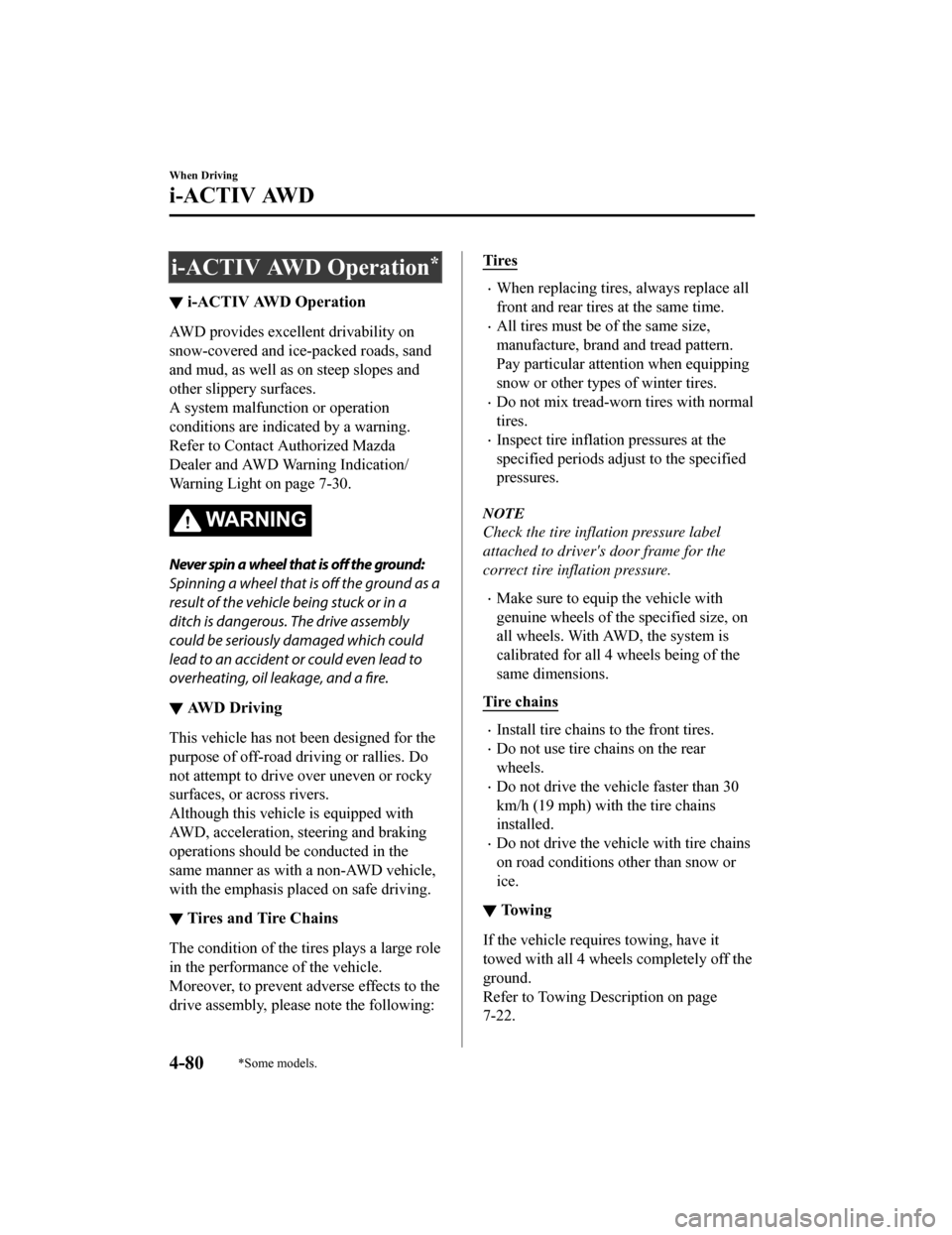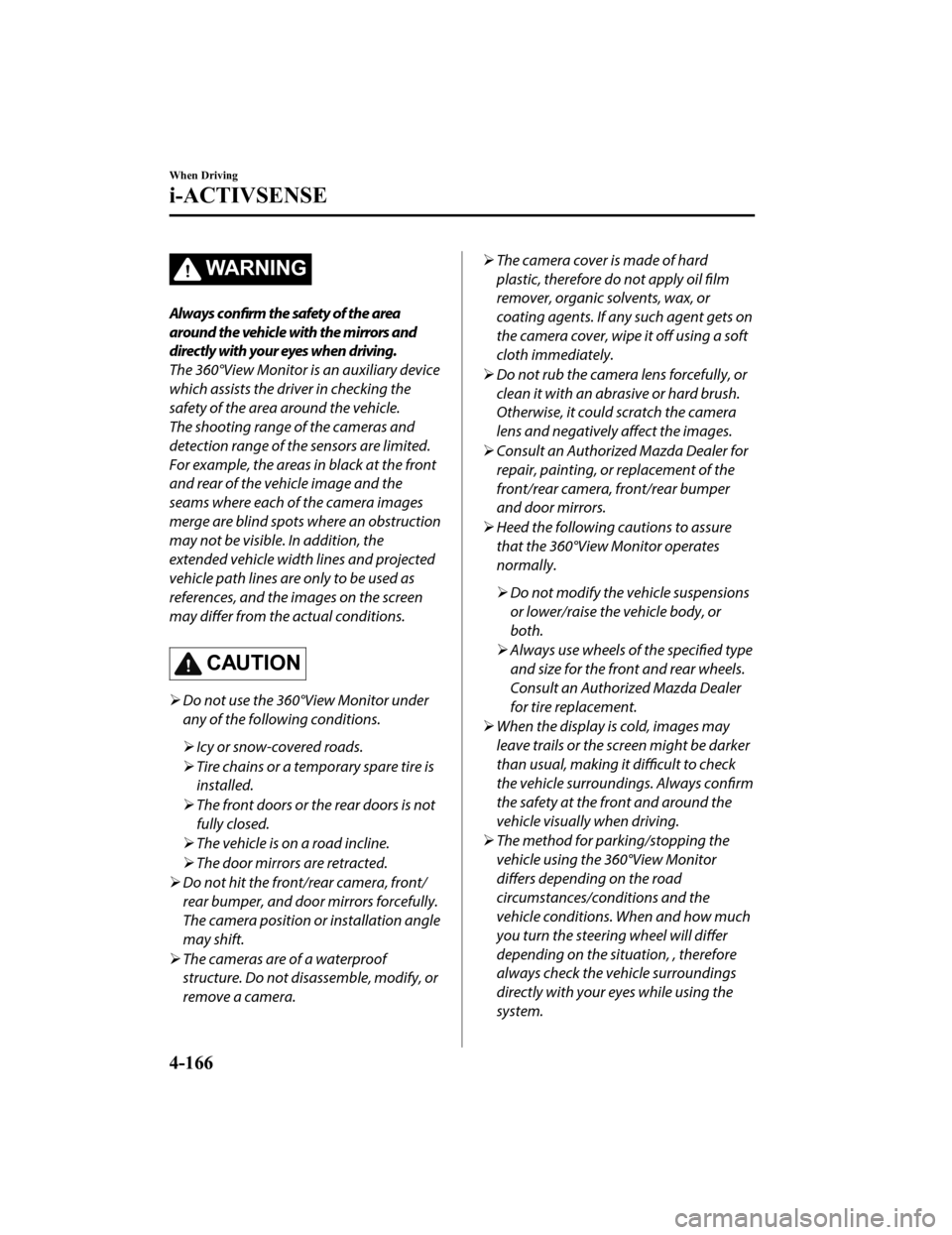Oil MAZDA MODEL 3 HATCHBACK 2019 Owners Manual (in English)
[x] Cancel search | Manufacturer: MAZDA, Model Year: 2019, Model line: MODEL 3 HATCHBACK, Model: MAZDA MODEL 3 HATCHBACK 2019Pages: 592, PDF Size: 12.19 MB
Page 38 of 592

Do not operate a vehicle with a damaged
seat belt:
Using a damaged seat belt is dangerous.
An accident could damage the belt
webbing of the seat belt in use. A damaged
seat belt cannot provide adequate
protection in a collision. Have an
Authorized Mazda Dealer inspect all seat
belt systems in use during an accident
before they are used again.
Have your seat belts changed immediately
if the pretensioner or load limiter has been
expended:
Always have an Authorized Mazda Dealer
immediately inspect the seat belt
pretensioners and air bags after any
collision. Like the air bags, the seat belt
pretensioners and load limiters will only
function once and must be replaced after
any collision that caused them to deploy. A
seat belt with an expended pretensioner or
load limiter is still better than wearing no
seat belt at all; however, if the seat belt
pretensioners and load limiters are not
replaced, the risk of injury in a collision will
increase.
Positioning the Shoulder Portion of the
Seat Belt:
Improper positioning of the shoulder
portion of the seat belt is dangerous.
Always make sure the shoulder portion of
the seat belt is positioned across your
shoulder and near your neck, but never
under your arm, on your neck, or on your
upper arm.Positioning the Lap Portion of the Seat Belt:
The lap portion of the seat belt worn too
high is dangerous. In a collision, this would
concentrate the impact force directly on
the abdominal area, causing serious injury.
Wear the lap portion of the belt snugly and
as low as possible.
CAUTION
Belt retraction may become difficult if the
belts and rings are soiled, so try to keep
them clean. For more details about
cleaning the seat belts, refer to "Seat Belt
Maintenance" (page 6-49).
1. Ring
Essential Safety Equipment
Seat Belt Systems
2-24
Mazda3_8HE9-EA-18K_Edition1 2018-10-17 19:05:10
Page 136 of 592

Winter Driving
▼Winter Driving
Carry emergency gear, including tire
chains, window scraper, flares, a small
shovel, jumper cables, and a small bag of
sand or salt.
Ask an Authorized Mazda Dealer to check
the following:
Have the proper ratio of antifreeze in the
radiator.
Refer to Engine Coolant on page 6-17.
Inspect the battery and its cables. Cold
reduces battery capacity.
Use an engine oil appropriate for the
lowest ambient temperatures that the
vehicle will be driven in (page 6-15).
Inspect the ignition system for damage
and loose connections.
Use washer fluid made with
antifreeze―but do not use engine
coolant antifreeze for washer fluid (page
6-19).
NOTE
Remove snow before driving. Snow left
on the windshield is dangerous as it
could obstruct vision.
Do not apply excessive force to a
window scraper when removing ice or
frozen snow on the mirror glass and
windshield.
Never use warm or hot water for
removing snow or ice from windows and
mirrors as it could result in the glass
cracking.
Drive slowly. Braking performance can
be adversely affected if snow or ice
adheres to the brake
components. If this
situation occurs, drive the vehicle
slowly, releasing the accelerator pedal
and lightly applying the brakes several
times until the brake performance
returns to normal.
▼ Snow Tires
Use snow tires on all four wheels
Do not go faster than 120 km/h (75 mph)
while driving with sno
w tires. Inflate snow
tires 30 kPa (0.3 kgf/cm
2, 4.3 psi) more
than recommended on the tire pressure
label (driver's door frame), but never more
than the maximum c old-tire pressure
shown on the tires.
Mexico
The vehicle is originally equipped with
summer tires designed for optimum
traction on wet and dry roads. If your
vehicle is to be used on snow and ice
covered roads, Mazda recommends that
you replace the tires originally equipped
on your vehicle with snow tires during the
winter months.
Except Mexico
The vehicle is originally equipped with all
season radials designed to be used all year
around. In some extreme climates you
may find it necessary t o replace them with
snow tires during the winter months to
further improve traction on snow and ice
covered roads.
Before Driving
Driving Tips
3-46
Mazda3_8HE9-EA-18K_Edition1 2018-10-17 19:05:10
Page 151 of 592

Cylinder Deactivation*
▼Cylinder Deactivation
The cylinder deactivation is a function
designed to reduce fuel consumption and
improve fuel economy by deactivating 2
out of the 4 cylinders while driving. The
function constantly determines which is
better for driving; 4 cylinders or 2
cylinders, regardless of the driver's
operations, and it performs the switching
automatically.
When the cylinder de
activation function
does not operate
The cylinder deactivation function does
not operate under the following
conditions.
The selector lever is in the P, N, or R
position (automatic transmission), or 1st
gear (manual transmission).
The engine oil temperature or engine
coolant temperature is low.
After disconnecting the battery
terminals for some reason, such as for
battery replacement.
When Driving
Start/Stop Engine
*Some models.4-11
Mazda3_8HE9-EA-18K_Edition1 2018-10-17 19:05:10
Page 162 of 592

▼Warning Indication/Warning Lights
These lights turn on or flash to notify the user of the system
operation status or a system
malfunction.
Signal Warning Refer to
Brake System Warning Indication/Warning Light*17-26
ABS Warning Indication/Warning Light*1
Electronic Brake
Force Distribu‐ tion SystemWa r n i n g 7-27
ABS warning 7-29
Charging System Warning Indication/Warning Light*17-27
Engine Oil Warning Indication/Warning Light*17-27
High Engine Coolant Temperat ure Warning Indication 7-28
Power Steering Malfunction Indication/Indicator Light*17-28
Master Warning Indication 7-29
Brake Control System Warning Indication/Warning Light*17-29
Brake Override Warning Indication 7-30
Check Engine Indication/Light*17-30
*Automatic Transmission Warning Indication/Warning Light*17-30
*AWD Warning Indication/Warning Light*17-30
Air Bag/Front Seat Belt Pretensi oner System Warning Indication/ Wa r n i n g
Light*17-31
When Driving
Instrument Cluster and Display
4-22*Some models.
Mazda3_8HE9-EA-18K_Edition1 2018-10-17 19:05:10
Page 163 of 592

SignalWarning Refer to
Tire Pressure Monitoring System (TPMS) Warning Indication/Warni ng
Light*1
Flashing 7-32
Turns on 7-36
(Red) KEY Warning Indication/Warning Light
*17-32
(Amber)
*High Beam Control System (HBC) Warning Indication/Warning Light*17-33
*i-ACTIVSENSE Warning Indication/Warning Light*17-33
Exterior Light Warning I
ndication/Warning Light*17-33
Low Fuel Warning Indication/Warning Light 7-33
Check Fuel Cap Warning Indication/Warning Light*17-34
Engine Oil Level Warning Indication/Warning Light*17-34
Seat Belt Warning Indication/Warning Light (Front seat) 7-34
(Red)Seat Belt Warning Light (Rear seat) 7-35
*Low Washer Fluid Level Warning Indication/Warning Light
7-35
Door-Ajar Warning Indication
7-36
*Trunk lid-Ajar Warning Indication 7-36
*Liftgate-Ajar Warning Indication 7-36
When Driving
Instrument Cluster and Display
*Some models.4-23
Mazda3_8HE9-EA-18K_Edition1
2018-10-17 19:05:10
Page 167 of 592

▼Wrench Indication/Indicator Light
The wrench indication/indicator light is
displayed/turns on un
der the following
conditions.
When the preset maintenance period has
arrived.
Refer to the Information section in the
Mazda Connect Owner's Manual.
When the engine oil replacement period
has arrived.
NOTE
The wrench indication/indicator light
may display/turn on earlier than the
preset period depending on vehicle
usage conditions.
Whenever the engine oil is replaced, a
reset of the vehicle engine control unit is
necessary.
Refer to the Information section in the
Mazda Connect Owner's Manual.
When Driving
Instrument Cluster and Display
4-27
Mazda3_8HE9-EA-18K_Edition1 2018-10-17 19:05:10
Page 220 of 592

i-ACTIV AWD Operation*
▼i-ACTIV AWD Operation
AWD provides excellent drivability on
snow-covered and ice-packed roads, sand
and mud, as well as on steep slopes and
other slippery surfaces.
A system malfunction or operation
conditions are indicated by a warning.
Refer to Contact Authorized Mazda
Dealer and AWD Warning Indication/
Warning Light on page 7-30.
WA R N I N G
Never spin a wheel that is
off the ground:
Spinning a wheel that is off the ground as a
result of the vehicle being stuck or in a
ditch is dangerous. The drive assembly
could be seriously damaged which could
lead to an accident or could even lead to
overheating, oil leakage, and a fire.
▼ AWD Driving
This vehicle has not been designed for the
purpose of off-road driving or rallies. Do
not attempt to drive over uneven or rocky
surfaces, or across rivers.
Although this vehicle is equipped with
AWD, acceleration, steering and braking
operations should be conducted in the
same manner as with a non-AWD vehicle,
with the emphasis placed on safe driving.
▼Tires and Tire Chains
The condition of the tires plays a large role
in the performance of the vehicle.
Moreover, to prevent adverse effects to the
drive assembly, please note the following:
Tires
When replacing tires, always replace all
front and rear tires
at the same time.
All tires must be of the same size,
manufacture, brand and tread pattern.
Pay particular attention when equipping
snow or other types of winter tires.
Do not mix tread-worn tires with normal
tires.
Inspect tire inflation pressures at the
specified periods adjust to the specified
pressures.
NOTE
Check the tire inflation pressure label
attached to driver's door frame for the
correct tire inflation pressure.
Make sure to equip the vehicle with
genuine wheels of the specified size, on
all wheels. With AWD, the system is
calibrated for all 4 wheels being of the
same dimensions.
Tire chains
Install tire chains to the front tires.
Do not use tire chains on the rear
wheels.
Do not drive the veh icle faster than 30
km/h (19 mph) with the tire chains
installed.
Do not drive the vehicle with tire chains
on road conditions other than snow or
ice.
▼ To w i n g
If the vehicle requires towing, have it
towed with all 4 wheels completely off the
ground.
Refer to Towing Description on page
7-22.
When Driving
i-ACTIV AWD
4-80*Some models.
Mazda3_8HE9-EA-18K_Edition1
2018-10-17 19:05:10
Page 277 of 592

Pedestrians
Stationary objects (stopped vehicles,
obstructions)
If a vehicle ahead is traveling at an
extremely low speed, the system may
not detect it correctly.
If there is a structure on the road or an
object (such as a monorail) at a low
height off the ground in front of the
vehicle, the system may operate.
Therefore, do not use the CTS.
Do not use the CTS system under
conditions in which close proximity
warnings are frequently activated.
If it is necessary to accelerate for a lane
change or the vehicle ahead brakes
suddenly causing you to close in on the
vehicle rapidly, accelerate using the
accelerator pedal or decelerate using
the brake pedal depending on the
conditions.
While the CTS function system is in use,
it does not cancel even if the selector
lever is operated and any intended
engine braking does not occur. If
deceleration is required, lower the set
speed or depress the brake pedal.
You might hear the sound of the
automatic brakes operating; however, it
does not indicate a problem.
The brake lights turn on while the CTS
automatic braking is operating.
Under the following conditions, the CTS
may not be able to detect white (yellow)
lines correctly and the CTS may not
operate normally.
The CTS may not operate normally
under the following conditions.
The forward sensing camera (FSC)
cannot recognize the area in front of
the vehicle due to soiling or fog.
The white (yellow) lane lines are less
visible because of dirt or paint
flaking.
White (yellow) lane lines are less
visible because of bad weather (rain,
fog, or snow).
The vehicle is driven on a temporary
lane or section with a closed lane
resulting from construction where
there might be multiple white (yellow)
lane lines, or they are interrupted.
The camera picks up an obscure line,
such as a temporary line being used
for construction, or because of shade,
unmelted snow, or grooves filled with
water.
The road surface is wet and shiny
after rain, or there are puddles on the
road.
Heavy luggage is loaded in the
luggage compartment or on the rear
seat causing the vehicle to tilt.
A vehicle in front of your vehicle is
running near a white (yellow) lane
line making it less visible.
The windshield is dirty or foggy.
The tire pressures are not adjusted to
the specified pressure.
Tires other than standard tires are
equipped.
The vehicle is driven through an
intersection, a junction, or a fork in
the road.
While white (yellow) lane lines cannot
be detected due to road or weather
conditions.
The surrounding brightness suddenly
changes such as when entering or
exiting a tunnel.
The illumination of the headlights is
weakened because of dirt or the
optical axis is deviated at night.
When Driving
i-ACTIVSENSE
4-137
Mazda3_8HE9-EA-18K_Edition1 2018-10-17 19:05:10
Page 306 of 592

WA R N I N G
Always confirm the safety of the area
around the vehicle with the mirrors and
directly with your eyes when driving.
The 360°View Monitor is an auxiliary device
which assists the driver in checking the
safety of the area around the vehicle.
The shooting range of the cameras and
detection range of the sensors are limited.
For example, the areas in black at the front
and rear of the vehicle image and the
seams where each of the camera images
merge are blind spots where an obstruction
may not be visible. In addition, the
extended vehicle widt h lines and projected
vehicle path lines are only to be used as
references, and the images on the screen
may differ from the actual conditions.
CAUTION
Do not use the 360°View Monitor under
any of the following conditions.
Icy or snow-covered roads.
Tire chains or a temporary spare tire is
installed.
The front doors or the rear doors is not
fully closed.
The vehicle is on a road incline.
The door mirrors are retracted.
Do not hit the front/rear camera, front/
rear bumper, and door mirrors forcefully.
The camera position or installation angle
may shift.
The cameras are of a waterproof
structure. Do not di sassemble, modify, or
remove a camera.
The camera cover is made of hard
plastic, therefore do not apply oil film
remover, organic solvents, wax, or
coating agents. If any such agent gets on
the camera cover, wipe it
off using a soft
cloth immediately.
Do not rub the camera lens forcefully, or
clean it with an abrasive or hard brush.
Otherwise, it could scratch the camera
lens and negatively affect the images.
Consult an Authorized Mazda Dealer for
repair, painting, or replacement of the
front/rear camera, front/rear bumper
and door mirrors.
Heed the following cautions to assure
that the 360°View Monitor operates
normally.
Do not modify the vehicle suspensions
or lower/raise the vehicle body, or
both.
Always use wheels of the
specified type
and size for the front and rear wheels.
Consult an Authorized Mazda Dealer
for tire replacement.
When the display is cold, images may
leave trails or the screen might be darker
than usual, making it
difficult to check
the vehicle surroundings. Always confirm
the safety at the front and around the
vehicle visually when driving.
The method for parking/stopping the
vehicle using the 360°View Monitor
differs depending on the road
circumstances/conditions and the
vehicle conditions. When and how much
you turn the steering wheel will differ
depending on the situation, , therefore
always check the vehicle surroundings
directly with your eyes while using the
system.
When Driving
i-ACTIVSENSE
4-166
Mazda3_8HE9-EA-18K_Edition1 2018-10-17 19:05:10
Page 340 of 592

The Forward Sensing Camera (FSC)
includes a function for detecting a soiled
windshield and informing the driver,
however, depending on the conditions, it
may not detect plastic shopping bags, ice
or snow on the windsh ield. In such cases,
the system cannot accurately determine
a vehicle ahead and may not be able to
operate normally. Always drive carefully
and pay attention to the road ahead.
NOTE
In the following cases, the Forward
Sensing Camera (FSC) cannot detect
target objects correctly, and each system
may be unable to operate normally.
The height of the vehicle ahead is low.
You drive your vehicle at the same
speed as the vehicle ahead.
Headlights are not turned on during
the night or when going through a
tunnel.
In the following cases, the Forward
Sensing Camera (FSC) may not be able
to detect target objects correctly.
Under bad weather condition, such as
rain, fog and snow.
The window washer is being used or
the windshield wipers are not used
when it's raining.
Ice, fog, snow, frost, rainfall, dirt, or
foreign matter such as a plastic bag is
stuck on the windshield.
Trucks with low lo ading platforms and
vehicles with an extremely low or high
profile.
When driving next to walls with no
patterning (including fences and
longitudinally striped walls).
The taillights of the vehicle ahead are
turned off.
A vehicle is outside the illumination
range of the headlights.
The vehicle is making a sharp turn, or
ascending or descending a steep
slope.
Entering or exiting a tunnel.
Heavy luggage is loaded causing the
vehicle to tilt.
Strong light is shone at the front of the
vehicle (back light or high-beam light
from on-coming vehicles).
There are many light emitters on the
vehicle ahead.
When the vehicle ahead is not
equipped with taillights or the
taillights are turned off at nighttime.
Elongated luggage or cargo is loaded
onto installed roof rails and covers
the Forward Sensing Camera (FSC).
Exhaust gas from the vehicle in front,
sand, snow, and water vapor rising
from manholes and grating, and water
splashed into the air.
When towing a malfunctioning
vehicle.
The vehicle is driven with tires having
significantly different wear.
The vehicle is driven on down slopes
or bumpy roads.
There are water puddles on the road.
The surroundings are dark such as
during the night, early evening, or
early morning, or in a tunnel or
indoor parking lot.
The illumination brightness of the
headlights is reduced or the headlight
illumination is weakened due to dirt
or a deviated optical axis.
When Driving
i-ACTIVSENSE
4-200
Mazda3_8HE9-EA-18K_Edition1 2018-10-17 19:05:10